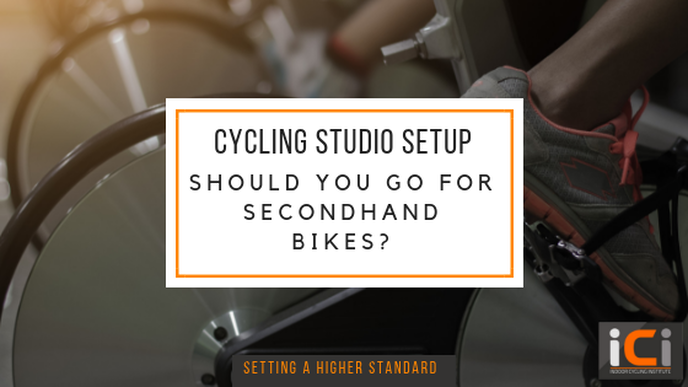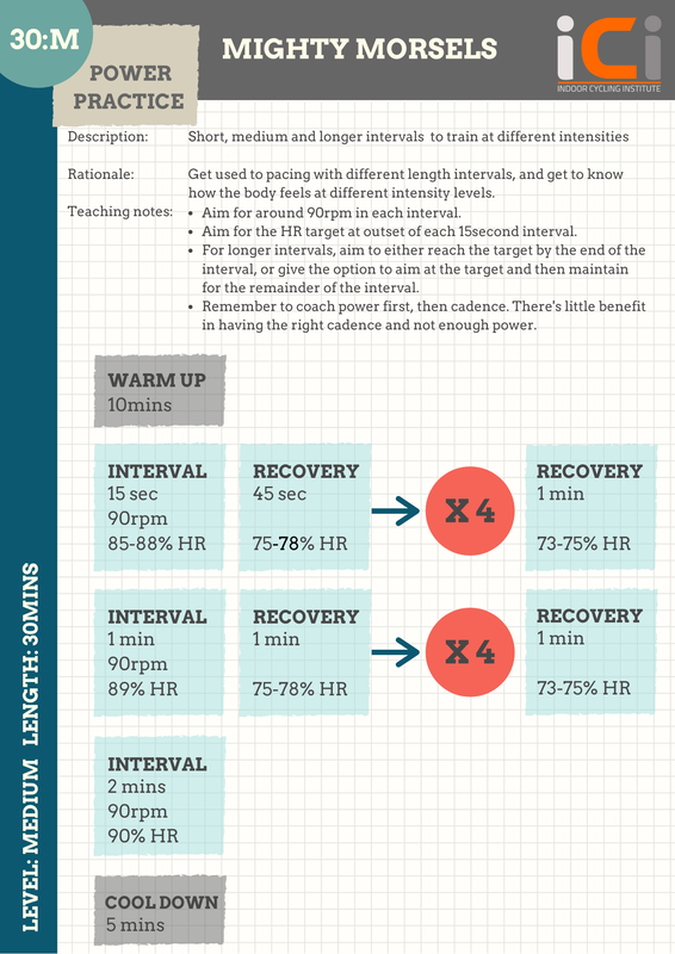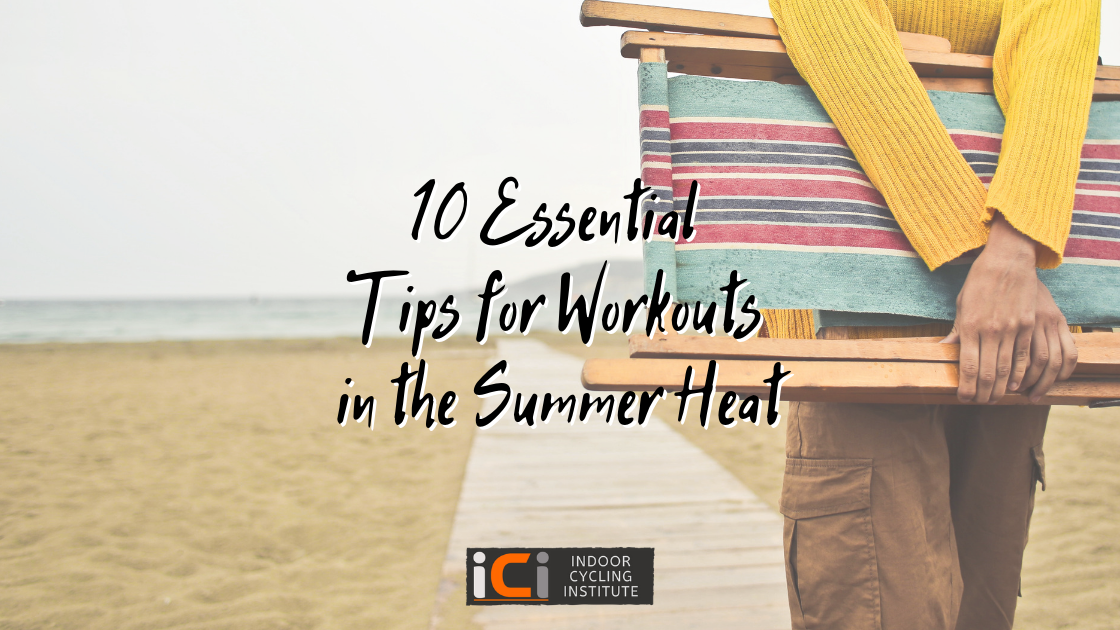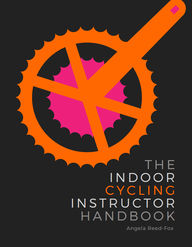by Angela Reed Fox Indoor Cycling Studio Manager question: Should you go secondhand for studio bikes?Setting up an indoor cycling studio? One way to get the party started is not to invest in the newest kit, but to go secondhand if there's a local opportunity.
You'll need to weight up the opportunity on its own merit - you need to be thinking about more than just the price. There are two main things to consider:
Are the bikes in reasonable condition? You really need to have a good look, and definitely do checks on all the ones you’re considering buying. The things you need to consider especially considering the price, are:
So that’s all stuff to work out if they’re reasonably priced. But you also need to consider how to future proof the investment you’ll be making in indoor cycling for your venue. Future-proofing your venue
It might be that you’re thinking of just getting some bikes in just to get started, and with a view to upgrading them in the next year or so – that could be an idea. It might be that you're considering secondhand bikes as a first step, to build your studio, and then to invest in better bikes further down the line. There’s usually a way round most things that are not ideal, we’ve found, and we’re happy to help you find the best approach for you. And also we’ve found that gimmicks definitely aren’t the way forward (there’s a reason why cycling studios don’t have bubble machines! We didn’t know this before we bought one when we first opened!) If you'd like us to help or offer advice, get in touch. We are keen to improve the quality of indoor cycling everywhere. It's a tremendously effective activity that can benefit a great variety of people when done properly - and we want to help you make it a success where you are. Of course the best investment you can make in your studio is ensuring your instructors are trained to a high enough standard that they are able to deliver safe, effective and effiicient classes that will boost rider motivation, results, and stickability. A good instructor will make the best of the bikes on offer - a poor instructor will struggle to create an effective class with even the best bikes on the market. We partner with venues to constantly improve their offering - and we endorse those who meet our standards and who are providing reliably good service to their riders. Ask us for more information.
0 Comments
Indoor Cycling Instructor Dictionary of Intervals: Bobble HatsPosition or interval: The bobble hat is an interval. What it is: A series of stages of increasing intensity, before gradually decreasing the intensity. Cadence: You select the cadence. You have a choice with cadence - you can either stick with the same cadence right the way through, and increase the challenge by increasing resistance, or you can keep the resistance the same, but try to increase the cadence as you go through the stages. Intensity: The intensity increases as you head through the stages of the climb. you may start pretty easy, and end moderately challenging, or you may start at a harder intensity and end really hard. The 'bobble' of the hat is a high intensity interval - a standing attack or a sprint, and then the intensity decreases gradually, delaying the recovery. Length: A bobble hat will last for minutes in total - it's up to you how long you make it; could just be 4-5 minutes, or you could make it longer, 10 minutes or more. You also get to decide how long each stage within the climb is. We recommend an absolute minimum of 30 seconds for each stage, with the high intensity interval at the top 15 seconds, although 1 minute works very well for the stages excluding the high intensity one. For very long climbs, spreading the stages out to 2 minutes each is incredibly challenging both mentally and physically. With each stage, you'll be adding challenge by either increasing resistance, or cadence, or both. You can split the bobble hat - use it whole for maximum challenge, but you can use the principle of the progressive climb leading to a maximal interval or the other principle of maximal interval followed by delayed recovery and gradually decreasing steps of intensity towards recovery. When to use: This is a very challenging interval, and therefore it's best used in the second half of a session - but due to the decreasing intensity towards recovery, it's best not to use it as the final challenge of the session as you'll want all riders to finish on a rather than a decrease. What it does: Builds strength and endurance, at higher intensities. Key teaching points:
If you want to be an excellent indoor cycling instructor, then we want to help ensure you get there. Click below to book your spot now, or to get further information.
Crimes Against Indoor Cycling: Two Turns Up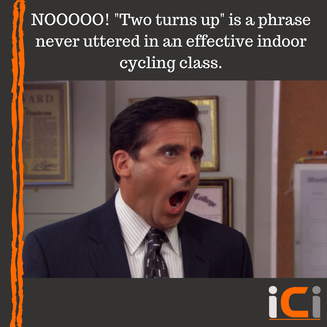 But you've heard it, right? Lemme tell you why it's not effective and therefore most definitely not best practice... 1. If the bikes are not well-maintained (weekly matenance check and repairs are required as a minumum) then it's not long before bikes develop personalities of their own. Some will be evil, and some will be nice. Riders quickly work out which bike is which. Two turns up on the Hufflepuff bike is not at all the same as two turns on Slytherin, get my meaning? 2. No rider is the same. Two turns up means different things to the rider who weighs only 52kg, the rider who regular participates in triathlons, and the rider who is trying to lose 10kg. It's all about fitness, muscle strength, bodyweight, and a whole host of other factors. What should you do instead? The key is to give riders the information they need to replicate the workout you've planned for them on their own bikes. Describe how the effort should feel - at what point should they start to feel breathless? When will their heartrates reach their anaerobic zone, if at all? At what point should their quads start to feel the extra effort? How long should they be able to sustain the effort? These are quick ways to give riders an idea of the intensity you have in mind. If they replicate this - they'll all get the same workout regardless of their fitness level, body composition or other factors. ICI instructors offer best practice to their classes. The focus is on safe, effective and efficient classes that get their riders results. More info? Click below.
10 Essential Tips for Indoor Cycling Workouts in the Summer HeatYes it's best not to let the weather sidetrack your riders from achieving their fitness goals. And yes, others may use the weather as an excuse. To keep maintain their progress, pass on these tips to get the most of working out in the summer heat. Click the link above for a pretty downloadable version. Hydrate, hydrate, hydrate. That means, pre-hydrate, hydrate, and post-hydrate. If you get hydration right, you'll avoid heat headaches. Get into the habit of being well hydrated every day. However it works for you - whether that's always having a bottle of water at your elbow, or having a drink with and between each meal, using a hydration app, however it works for you, build the habit. This is great for your brain, great for your skin, great for everything. And when the weather heats up, you're already on a roll. Over-hydration is a thing though. If you drink everything you can find, you'll be on the fast train to hyponatraemia, which happens when you pee out all that excess water (and sodium gets washed away with it). Drink to thirst during your workout - or take the hint of sipping (and definitely sip, don't glug) with each recovery section. Afterwards, maintain your healthy hydration habits - at least for the 24 hours after your workout, but if it's worth doing, it's worth keeping, right? Build the habit! Wear clothes! Yeah, not just any clothes - wear clothes that wick the moisture away from your skin, clothes that are light and loose-ish (but not flappy). Change your timetable Try earlier sessions before the day heats up. Early morning sessions enable you to get your stuff done before breakfast - in the coolest part of the day. Precooling Yep, it's a thing. Have an iced drink or a cold shower just before your workout if it's a really hot, humid day. There's evidence to suggest that this will also improve your performance (and who doesn't want that?!) You'll start your workout feeling fresher and cooler, and that feeling will last you just that little bit longer. Don't ignore your warm up "But I'm already warm!" Yes, you are, but one of the reasons we warm up is so that we're supplying more blood to muscles, which means they get more oxygen - and that means you can work harder and more intensely, giving you better results. You skip the warm up and you'll miss out. Fans are your friend If you're going to be working out inside, make sure it's somewhere that has fans not just air conditioning. Air con is no help at all when you feel hot during a workout. It's cold when you first walk in, but as soon as you're into your workout, you lose the benefit, and then when you head for your cool down, that icy air con blast hits you right when you need it least! Head for the fans. It makes sense - they're on when you need them, and off when you don't. Listen carefully Be body aware. Overheating can leave you dizzy, nauseous and clammy. It's unpleasant, and you can avoid it by turning down the intensity when your body feels like it's had enough. Sit out for a few minutes, or head for your aerobic heartrate zones - there's plenty of benefit to be had from working aerobically. Choose aerobic sessions when you're planning your week's workout. Cool down properly Don't rush off immediately after the workout bit. Take the cool down leisurely. Take time to bring your heartrate down. Make sure you're recovering to your lower heartrate zones before you start stretching. If you don't, you could feel dizzy or faint when you start stretching. Eat! Oh yes. Don't forget when you sweat, you loose electrolytes as well as water - and you'll need to replace these. If you don't have high blood pressure, then eating a portion of salted nuts, olives, crisps, or crackers will provide you with the sodium and carbs you body needs. Wee check! Check the colour of your urine - darker urine means you're dehydrated (think 'lager'). If it looks lighter and more like sauvignon blanc, then you're probably well-hydrated. If it's super-pale , you're at risk of over-hydrating (but this isn't particularly usual). If it's got a pinkish, brownish or other unusual tinge (and you haven't been eating beetroots or vitamin tablets) you might like to go and get that checked. And there we are. You're equipped to smash your fitness goals even in a glorious British summer (you never know, this could be it!) And of course, at ICI we're here to help. It's our thing to keep you happy, healthy, and get you even fitter than ever. Here's to summer! If you're an instructor or a gym manager, we can help you to deliver quality classes that are safe, effective and efficient. That's what we do. Click below to contact us: Endorsed venues: contact us for your co-branded guide.
|
Categories
All
|
||||||||||
- Home
- Courses
-
Course dates
- UK indoor cycling instructor training >
- Canada Indoor cycling instructor training
- US Indoor cycling instructor training
- Australia Indoor cycling instructor training
- New Zealand Indoor cycling instructor training
- Europe Indoor cycling instructor training
- Denmark Indoor cycling instructor training
- Norway Indoor cycling instructor training
- Contact
- Shop
- Code of Conduct
- Terms and conditions
Quick links
Get started
|
Find what's right for you
|
Courses
|
Further learning
|
More
|
The Indoor Cycling Institute provides the most comprehensive and up to date indoor cycling instructor training; providing entry-level courses, and further education to raise the standard of instructors.
© 2014-2024 Protheorem Ltd
The Indoor Cycling Institute is owned and operated by Protheorem Ltd Registered in England & Wales, Company number 12812092
The Indoor Cycling Institute is owned and operated by Protheorem Ltd Registered in England & Wales, Company number 12812092

